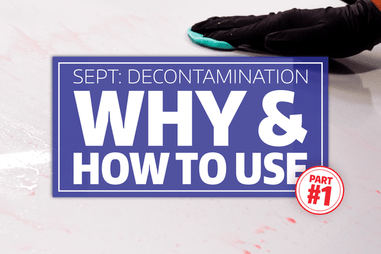Why Paint Decontamination is Important & How to Use it: Part 1 of 2
4th Sep 2025 @ 3:18 PM
Say Goodbye to Grime! The Power of Decontamination Sprays and Clay Bars for a Smooth Finish
Greetings car enthusiasts!
Have you ever run your hand over your freshly washed car and still felt tiny bumps and roughness? Don't worry, you're not alone! Even after a thorough wash, your vehicle's paint can harbor embedded contaminants that soap and water alone can't remove. These stubborn particles, like industrial fallout, brake dust, tree sap, and road grime, cling to your paint's clear coat, making it feel rough, dulling its shine, and prevent your favorite waxes and sealants from bonding properly.
Autogeek can help! That's where the dynamic duo of decontamination sprays and clay bars comes to the rescue. Think of it as a deep cleansing treatment for your car's paint.
Why Decontaminate?
Before we dive into the "how," let's talk about the "why." Removing these embedded contaminants is crucial for several reasons:
- Enhances Shine and Smoothness: By eliminating the rough texture caused by bonded contaminants, your paint will feel incredibly smooth and reflect light more evenly, giving you that coveted deep gloss.
- Improves Wax and Sealant Performance: When your paint is clean and free of debris, your waxes and sealants will adhere properly and last longer, providing better protection and a more durable shine.
- Prepares for Polishing: If you're planning on polishing your car to remove swirls and scratches, decontamination is the vital first step. Polishing over embedded contaminants can actually scratch the paint further.
The Decontamination Process: A Step-by-Step Guide
Here's how to use decontamination sprays and clay bars to achieve a silky smooth finish:
- Wash Your Car: Start with a thorough wash to remove loose dirt and grime. We recommend a 2-bucket wash method.
- Spray Decontamination Spray: Working in sections, typically one panel at a time, liberally spray a dedicated decontamination product like SONAX Fallout Remover, CarPro IronX, BLACKFIRE Iron Remover, or GYEON Q2M Iron Remover onto the paint. These sprays are designed to chemically loosen and dissolve iron particles and other contaminants. Let the product dwell for the recommended time (always follow the manufacturer's instructions), and you will see a color change (often purple) as the product reacts with iron deposits.
- Rinse Thoroughly: After the dwell time, thoroughly rinse the panel with water.
- Lubricate with Clay Lube: Now it's time for the clay bar. Take a piece of your clay bar and flatten it into a patty. Generously spray the panel with a dedicated clay lubricant like Pinnacle Clay Lubricant, or BLACKFIRE Clay Lubricant. The lubricant is essential to prevent the clay bar from scratching your paint. Never use water alone.
- Clay the Surface: Gently glide the clay bar back and forth over the lubricated surface using light pressure. You'll feel the clay bar pick up the remaining embedded contaminants. As the clay gets dirty, fold it over to reveal a clean surface. If you drop the clay bar on the ground, discard it to avoid introducing new scratches.
- Rinse & Wipe Clean: After claying a section, rinse and wipe away any remaining lubricant with a clean microfiber towel.
- Repeat: Continue this process panel by panel until you've decontaminated the entire vehicle.
- Final Rinse (Optional): You can give your car a final rinse.
- Protect Your Paint: Now that your paint is squeaky clean and smooth, it's the perfect time to apply your favorite wax or sealant to protect your hard work.
Pro Tip: Try the BLACKFIRE Clay Mitt for step 5. Easy to use and can be lubricated with car soap.
Decontaminating your car might seem like an extra step, but the results are worth every effort a couple times a year. You'll be amazed at how much smoother and glossier your paint will feel and look.
Pro Tip: Don't know if you car is ready for another round of decontamincation? Place your hand inside a clear plastic bag (like a zip lock) and gently rub your hand over the cars paint. Feel bumps? It's time to decon!

